The Age of Galileo
Astronomical & Historical Bytes
Inventions | Historical Notes | Images
Chapter Two
Dangerous Concept, Dangerous Times - Galileo, Kepler and the Church: Praise, Accolades and the Road to Conflict
"I much prefer the sharpest criticism of a single
intelligent man to the thoughtless approval of the masses."
- Johannes Kepler, German Astronomer 1571-1630
From Warfare to Stargazing: Galileo Creates His Telescope ∫∫∫
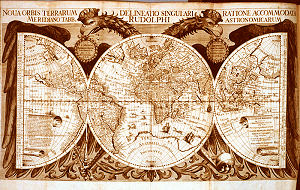 In May of 1609, Galileo had received a letter from Paolo Sarpi telling him about a spyglass that a Dutchman had shown to him in Venice and based on the description given him by Sarpi in this letter, set out to create a working model. But the road to discovery and fame is sometimes a path with many detours and Galileo's path had one by necessity: "Galileo had business commitments designing and manufacturing military and scientific instruments." [1] In fact, Lippershey himself had sold his device to the Dutch army who's interest in it was to view and estimate the size of an advancing force. Image: 17th Century Map [2] fn1
In May of 1609, Galileo had received a letter from Paolo Sarpi telling him about a spyglass that a Dutchman had shown to him in Venice and based on the description given him by Sarpi in this letter, set out to create a working model. But the road to discovery and fame is sometimes a path with many detours and Galileo's path had one by necessity: "Galileo had business commitments designing and manufacturing military and scientific instruments." [1] In fact, Lippershey himself had sold his device to the Dutch army who's interest in it was to view and estimate the size of an advancing force. Image: 17th Century Map [2] fn1
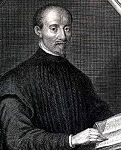 The initially enthusiastic reception of the telescope had nothing to do with observation of the skies, but rather revolved around the ability to see terrestrial objects. Galileo heard of the Dutch telescope while a professor at the University of Padua, which was part of the Republic of Venice. The Venetians realized the great value of the telescope for their merchant fleet as well as for use on dry land, and the State Council therefore encouraged and supported Galileo to continue his investigations and to develop his own telescope. - from Knowmagine-Andrea-Telescope Image: Paolo Sarpi by George Vertue (1684—1756) [3]
The initially enthusiastic reception of the telescope had nothing to do with observation of the skies, but rather revolved around the ability to see terrestrial objects. Galileo heard of the Dutch telescope while a professor at the University of Padua, which was part of the Republic of Venice. The Venetians realized the great value of the telescope for their merchant fleet as well as for use on dry land, and the State Council therefore encouraged and supported Galileo to continue his investigations and to develop his own telescope. - from Knowmagine-Andrea-Telescope Image: Paolo Sarpi by George Vertue (1684—1756) [3]
In a letter written to his brother-in-law Landucci, Galileo relates the events that occurred after he discovered a way to reproduce his own version of the new invention:
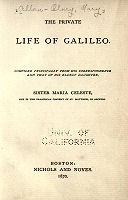 "...I set about thinking how to make it, and at length I found out, and have succeeded so well that the one I have made is far superior to the Dutch telescope. It was reported in Venice that I had made one, and a week since I was commanded to show it to his Serenity and to all the members of the Senate, to their infinite amazement.
Many gentlemen and senators, even the oldest, have ascended at various times the highest bell-towers in Venice, to spy out ships at sea making sail for the mouth of the harbor, and have seen them clearly, though without my telescope they would have been invisible for more than two hours. The effect of this instrument is to show an object at a distance of, say fifty miles, as if it were but five miles off.
"...I set about thinking how to make it, and at length I found out, and have succeeded so well that the one I have made is far superior to the Dutch telescope. It was reported in Venice that I had made one, and a week since I was commanded to show it to his Serenity and to all the members of the Senate, to their infinite amazement.
Many gentlemen and senators, even the oldest, have ascended at various times the highest bell-towers in Venice, to spy out ships at sea making sail for the mouth of the harbor, and have seen them clearly, though without my telescope they would have been invisible for more than two hours. The effect of this instrument is to show an object at a distance of, say fifty miles, as if it were but five miles off.
Perceiving of what great utility such an instrument would prove in naval and military operations, and seeing that his Serenity greatly desired to possess it, I resolved four days ago to go to the palace and present it to the Doge as a free gift. And on quitting the presence-chamber I was commanded to bide awhile in the hall of the Senate, whereunto, after a little, the Illustrissimo Prioli, who is Procurator and one of the Riformatori of the University, came forth to me from the presence-chamber, and, taking me by the hand, said that the Senate, knowing the manner in which I had served it for seventeen years at Padua, and being sensible of my courtesy in making it a present of my telescope, had immediately ordered the Illuseiectedto the trious Riformatori to elect me...to the professorship for life, with a...stipend of 1,000 florins year" - The Private Life of Galileo pp.49-50 (emphasis mine) Image: Inside cover of original text The Private Life of Gailieo [4]
 Galileo was obviously aware of both the practical uses for his new device as well as the tangible aspects of advancement, money and perhaps the fame that it could bring. Indeed, his actions and work for the Venetians, who supported his efforts at this time, were intended as a means of furthering his salary and standing. However, this never bore fruit and the two seemed to have had a falling out for fiscal reasons. As noted in an article from the School of Mathematics and Statistics, University of St Andrews, Scotland entitled Galileo Galilei:
Galileo was obviously aware of both the practical uses for his new device as well as the tangible aspects of advancement, money and perhaps the fame that it could bring. Indeed, his actions and work for the Venetians, who supported his efforts at this time, were intended as a means of furthering his salary and standing. However, this never bore fruit and the two seemed to have had a falling out for fiscal reasons. As noted in an article from the School of Mathematics and Statistics, University of St Andrews, Scotland entitled Galileo Galilei:
"He kept Sarpi informed of his progress and Sarpi arranged a demonstration for the Venetian Senate. They were very impressed and, in return for a large increase in his salary, Galileo gave the sole rights for the manufacture of telescopes to the Venetian Senate. It seems a particularly good move on his part since he must have known that such rights were meaningless, particularly since he always acknowledged that the telescope was not his invention!
The Venetian Senate, perhaps realising that the rights to manufacture telescopes that Galileo had given them were worthless, froze his salary. However he had succeeded in impressing Cosimo and, in June 1610, only a month after his famous little book was published, Galileo resigned his post at Padua and became Chief Mathematician at the University of Pisa (without any teaching duties) and 'Mathematician and Philosopher' to the Grand Duke of Tuscany. In 1611 he visited Rome where he was treated as a leading celebrity; the Collegio Romano put on a grand dinner with speeches to honour Galileo's remarkable discoveries. He was also made a member of the Accademia dei Lincei (in fact the sixth member) and this was an honour which was especially important to Galileo who signed himself 'Galileo Galilei Linceo' from this time on." - Galileo Galilei - Galileo Galilei by J J O'Connor and E F Robertson [5]
The Telescope Arrives - Galileo Moves On ∫∫∫
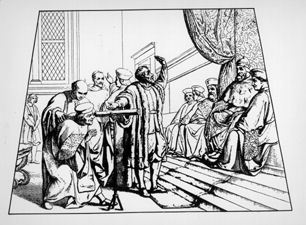 For Galileo, the telescope represented something far more important - advancement and the means of escaping the confines and responsibilities required of him while at the University of Padua. This was not a new desire, for Galileo had earlier drawn the correct and sombering truth of his position at Padua and expressed such when he wrote, in a letter to one Vespuccio of Florence,
For Galileo, the telescope represented something far more important - advancement and the means of escaping the confines and responsibilities required of him while at the University of Padua. This was not a new desire, for Galileo had earlier drawn the correct and sombering truth of his position at Padua and expressed such when he wrote, in a letter to one Vespuccio of Florence,
"It is impossible to obtain from a republic, however splendid and generous, a stipend without duties attached to it ; for to have anything from the public one must work for the public, and as long as I am capable of lecturing and writing, the Republic cannot hold me exempt from duty, while I enjoy the emolument. In short, I have no hope of enjoying such ease and leisure as are necessary to me, except in the service of an absolute prince." - The Private Life of Galileo p.59 et. seq. Image credit: Galileo Builds the First Telescope 1609 A.D. PBS Online [6]
Galileo, now forty-five years of age had been longing for the home in his heart, Florence. However, something and someone was needed in order to secure his future there or anywhere and Gailieo knew this. His letter to Vespuccio indicated as much but it also was a letter intending to lay the foundations for a move to Florence and because Galileo had nothing in hand to offer at that time, his desires needed to be kept secret a while longer,
"Thus succinctly, most gentle Signor Vespuccio, have I laid before you my thoughts. Whenever you see a fit opportunity for doing so, I would beg you to make the illustrious Signori Eneas and Silvio acquainted with the same. I know that I can thoroughly depend on the friendship of these two, and I shall have recourse to none besides. I therefore beg your lordship not to communicate the contents of this letter to any but these gentlemen." [ibid, pg.61]
 That "something" finally arrived, in the form of the new invention then spreading across the European continent - the telescope. Of course, being Galileo, a man who's life had till that time been devoted to the ‘working science of things’ (one will remember that he was a "most respected instrument maker") it would have been out of character for him not to have employed the telescope for more than just "tangible" gain, and so he did. In 1609, in Padua, Galileo pointed his telescope towards the Moon thus becoming the first to employ the new instrument to observe and document the celestial object. Image: A pair of refracting telescopes owned by Galileo Credit: His Telescope—Photos: (Telescope) © Corbis Images; Illustrations: © WGBH/NOVA
That "something" finally arrived, in the form of the new invention then spreading across the European continent - the telescope. Of course, being Galileo, a man who's life had till that time been devoted to the ‘working science of things’ (one will remember that he was a "most respected instrument maker") it would have been out of character for him not to have employed the telescope for more than just "tangible" gain, and so he did. In 1609, in Padua, Galileo pointed his telescope towards the Moon thus becoming the first to employ the new instrument to observe and document the celestial object. Image: A pair of refracting telescopes owned by Galileo Credit: His Telescope—Photos: (Telescope) © Corbis Images; Illustrations: © WGBH/NOVA
Galileo's star was about to rise to the highest echelons within the european scientific community and over the next three years, 1610-1613, his life, livelihood and character would change. Yet, at the same time, Galileo's ascent would manage to bring together, for better or worse, two separate and divergent trains of thought, scientific and spirtual, to the point of historic confrontation, causing a rift between science and religion that would last well into the 21st century.
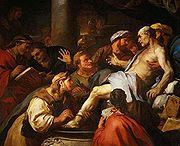 From within the Venetian senate came a handsome order for Galileo to supply the arsenal with spyglasses. Galileo was given a generous lifetime salary for his service to the republic. Part scientist and part self-promoter, for now, his future seemed bright. But soon his telescope would launch a dispute which would threaten to destroy its creator - from Galileo's Battle for the Heavens NOVA/PBS [**]
From within the Venetian senate came a handsome order for Galileo to supply the arsenal with spyglasses. Galileo was given a generous lifetime salary for his service to the republic. Part scientist and part self-promoter, for now, his future seemed bright. But soon his telescope would launch a dispute which would threaten to destroy its creator - from Galileo's Battle for the Heavens NOVA/PBS [**]
"non est ad astra mollis e terris via" — there is no easy way from the earth to the stars — Lucius Annaeus Seneca (c. 4 BC — AD 65) Image: Luca Giordano, The death of Seneca (1684)
Johannes Kepler - The German Comtemporary ∫∫∫
 Meanwhile, in the early part of 1609, a comtemporary of Galileo was making his own mark on science. In that year a German named Johannes Kepler published a work under the title "New Astronomy", and within its pages were Kepler's first two laws of planetary motion (the thrid would not arrive until 1618). Over the next months both men would independantly pursue (though Kepler's work, by this time, was ahead of Galileo's if only in the theoretical sense) what would eventual become the foundations that merged much of the scientific knowledge up to that time into modern theoretical and physical astronomy. Who was Johannes Kepler and what were his connections to Galileo are the subjects of our next chapters. Image Source: The Einstein Website Copyright © Hans-Josef Küpper
Meanwhile, in the early part of 1609, a comtemporary of Galileo was making his own mark on science. In that year a German named Johannes Kepler published a work under the title "New Astronomy", and within its pages were Kepler's first two laws of planetary motion (the thrid would not arrive until 1618). Over the next months both men would independantly pursue (though Kepler's work, by this time, was ahead of Galileo's if only in the theoretical sense) what would eventual become the foundations that merged much of the scientific knowledge up to that time into modern theoretical and physical astronomy. Who was Johannes Kepler and what were his connections to Galileo are the subjects of our next chapters. Image Source: The Einstein Website Copyright © Hans-Josef Küpper
Jupiter's Galilean Moon Ganymede
credit: APOD & Galileo Project, JPL, NASA
 Turn The Page ⇒
Chapter Two of Dangerous Concept, Dangerous Times: Galileo, Kepler and the Church - Johannes Kepler
Turn The Page ⇒
Chapter Two of Dangerous Concept, Dangerous Times: Galileo, Kepler and the Church - Johannes Kepler
Footnotes
1. Several sources indicated that Paolo Sarpi went to see Galileo while others state that he wrote to Galileo regarding his encounter with the dutchman and his device. Galileo himself wrote to Landucci, his brother-in-law, that he received word of the invention via a letter from Paolo Sarpi. Later however, Gailieo relates, in the Starry Messenger (Sidereus Nuncius), that in April 1610:
About ten months ago a report reached my ears that a certain Fleming had constructed a spyglass by means of which visible objects, though very distant from the eye of the observer, were distinctly seen as if nearby. Of this truly remarkable effect several experiences were related, to which some persons believed while other denied them. A few days later the report was confirmed by a letter I received from a Frenchman in Paris, Jacques Badovere, which caused me to apply myself wholeheartedly to investigate means by which I might arrive at the invention of a similar instrument. This I did soon afterwards, my basis being the doctrine of refraction. [see: Galileo Galilei, School of Mathematics and Statistics University of St Andrews Scotland]
This would place the date of his learning of the device between the months of May or June, 1609. There are other records which also indirectly confirm that Gailieo simply heard of the device in a letter around this time also. See reference [4] below and numbers [5] and [7] from Chptr.1, pg.2. Also see Galileo at Work-His Scientific Biography by Stillman Drake, Dover Phoenix Editions, pg.137 One conclusion that is shared by others is that Galileo was informed of the invention prior to his hearing the report of the "Fleming" Again, it is a matter of historical timing as to just when Galileo received news regarding the new device.
Return to above paragraph.












Chapter Two Bibliography
[ 1 ] Morris, Jim & Rhoda - SciTechAntiques.com, -Introduction- Building Museum Grade Replicas of the Telescopes attributed to Galileo. Precisely Replicated examples of Galileo's Existing Telescopes, Copyright 12/15/2006 by Jim & Rhoda Morris
[ 2 ] The First Telescope, Chptr.1 - Copyright © 2007 - Advameg Inc.
[ 3 ] KNOWMAGINE-ANDREA-TELESCOPE - Tel-Aviv University Science and Technology Education Center, Chosen as a Discovery Channel School's Great Books Program for spring 1999
[ 4 ] NICHOLS AND NOYES - "The Private Life of Galileo", Boston 1870. Riverside, Cambridge: Stereotyped and Printed by H. O. Houghton and Company. Complied principally from his correspondencs and that of his eldest daughter, Sister Maria Celeste, nun in the Franciscan Convent of St. Matther, in Arcetri. Archive location: Internet Archive text & image source
[ 5 ] Galileo Galilei - Article by J J O'Connor and E F Robertson, biographical, JOC/EFR © November 2002 not for free release. Printing allowed, see site for details. I am very grateful to the authors for their permission to reprint the above. Thank you. John J O'Connor Edmund F Robertson Mathematical Institute, University of St Andrews, North Haugh St Andrews e-mail: joc@st-andrews.ac.uk Scotland efr@st-andrews.ac.uk MACTUTOR HISTORY: http://www-history.mcs.st-and.ac.uk/ The University of St Andrews is a registered Scottish charity : No SC013532
[ 6 ] Galileo's Battle for the Heavens - NOVA/PBS Special, NOVA/PBS Images the book by Dava Sobel online, http://www.pbs.org/wgbh/nova/galileo/life.html (images), www.pbs.org/wgbh/nova/galileo/ (index)
[ 7 ] Fitzpatrick, Richard - Kepler's Model, 2006-07-28
[ 8 ] Kollerstrom, Nick - article "Galileo and the new star", Astronomy News 2004
[ 9 ] Giostra, Alessandro - Massimo Turatto, Stefano Benetti, Luca Zampieri, William Shea, eds. 1604-2004: Supernovae as Cosmological Lighthouses a Reference Publication from BNet CBS Interactive Inc. All rights reserved
[ 10 ] Shea, William R. and Artigas, Mariano - Galileo in Rome - The Rise and Fall of a Troublesome Genius, Oxford University Press Aug. 2004 ISBN13: 9780195177589 ISBN10: 0195177584 Link is to the BNet Brief
[ 11 ] Ice, Water, and Fire: The Galileo Europa Mission - The Planetary Report (Jan/Feb 1998) Galileo Orbiter & Probe
[ 12 ] Sarpi, Paolo - Venetian patriot, scholar, scientist and church reformer. Wikipedia, Revsion history: http://en.wikipedia.org/w/index.php?title=Paolo_Sarpi&action=history
[ 13 ] Reeves, Eileen - Kingdoms of Heaven: Galileo and Sarpi on the Celestial, Number Winter 2009, Pages 61—84 , DOI 10.1525/rep.2009.105.1.61 Posted online on January 28, 2009. doi:10.1525/rep.2009.105.1.61
Telescope 17th Century & The Year of Astronomy 2009

Celebrating 400 Years of Astronomy! US Node
Universe Awareness for Young Children A International Outreach Program for Children
400 Years of Astronomy Worldwide National Node
You can:
Close Window
Back To Main Page
Back One Page
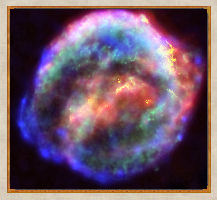
Kepler's Supernova Remnant SN1604.
Over 400 years ago both Kepler & Galileo saw the appearence of a bright new object in the sky that was initially brighter than Jupiter. Over the next few weeks the object dimmed, finally fading from view. NASA/CXC/NCSU/S.Reynolds et al. &
Chandra X-ray Observatory Website
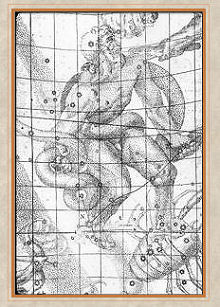
Kepler extensively studied this supernova, writing his observations in the book "De Stella nova in pede Serpentarii". The above illustration is from that work.
Of course, Kepler was fortunate enough to inherit an extensive set of naked-eye solar and planetary position data from the Danish astronomer Tycho Brahe (1546-1601). This data extended over many decades, and was of unprecedented accuracy. [7]
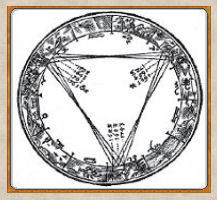
This diagram shows the sixty-year pattern of the two slowest-moving planets, Jupiter and Saturn. Their meetings in the sky were known as chronocrators and taken to measure out cycles of time in history. [8]
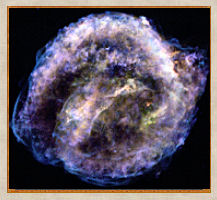
Kepler's Supernova Remnant in X-Rays
Galileo Galilei studied Kepler's Supernova as well, and it gave the Pisan scientist the opportunity to deliver three public lectures. Galilei's account of the celestial event, which he gave during his Paduan professorship, is illustrated by William R. Shea, Professor at the Cattedra Galileiana di Storia della Scienza at the University of Padua, in his paper "Galileo and the Supernova of 1604" [9] Image: APOD
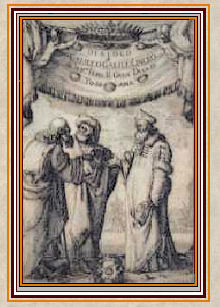 Illustration from the book by William R. Shea
Illustration from the book by William R. Shea
"Galileo's trial by the Inquisition is one of the most dramatic incidents in the history of science and religion. Today, we tend to see this event in black and white--Galileo all white, the Church all black." [10]
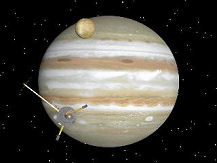
The Spacecraft Galileo Approaches the Moon Io
Named in honor of the great man himself, and after a six-year journey from Earth, Galileo arrived at Jupiter on December 7, 1995. "In moves designed to lock the spacecraft in orbit around the gaseous giant planet, Galileo swung by the moon Io, then fired its main engine, and in between, collected the precious data from the atmospheric probe it dropped five months earlier. For two years and 11 orbits during its Prime Mission, Galileo has revealed an array of fascinating details about Jupiter and its moons" [11]
You can:
Jump to the Index Page
Step Back One Page